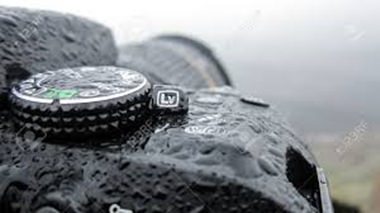This week’s article is for people who use their camera more than “infrequently”. People like Rodney James Charman who goes to every function known to mankind, and has a camera attached to his right arm. Rodders has been very satisfied with the photographic results of his Fuji, but recently has noticed that the casing was falling apart, with the leatherette coming off.

The camera was sent to the Thailand head office who repaired the old camera and gave their reasons for the deterioration. Heat and sweaty hands.
I too have seen that the rubbery outer casing on my Panasonic Lumix has “grown” and is coming away from the metal. Now I have noticed that black leatherette can do this and I had put it down to the ambient heat, even though the camera lives in one of those small padded camera bags. Beware the fact that when you step outside your car and into an air-conditioned room that the lens clouds up. That condensation is water, and cameras and water don’t mix.
Moisture and condensation are the easiest ones to counter, but the dampness comes from more than just being caught out in the rain. Thailand is a hot and humid environment. The best answer here is to keep small sachets of silica gel in your camera bag. When the silica gel changes color you can pop them back in the micro-wave and rejuvenate them very easily. Many bottles of tablets come with perfect little sachets in the top of them too.
There will also be times when you get caught in the rain, or you may even want to get rain shots. The camera body is reasonably water proof, but you should carefully wipe the outside of the case dry afterwards, and especially blow air around the lens barrel and the lens mount.
Please Support Pattaya Mail
So here are some tips on how to look after your photographic investments, which can run into big money! The first concept is to understand just what it is that will go towards destroying your camera. Usually these are simply dust and grit, moisture and condensation, battery acid and being dropped. Looking after your investment is then a simple case of countering the above factors.
Being dropped never benefits any camera, so the first procedure in the camera shop is to fit a neck strap and get her used to wearing it. Even if not around the neck, the strap should be wrapped around the wrist. The strap is like the safety belt in your car.
Dust and grit is the ever present danger in the environment. How many times have you got a small piece of grit in your eye? Often, I will wager. Small particles such as that can be very bad for the lens focusing and zooming mechanics too. There is really no secret here!
That leads us to the even more serious type of corrosion – leakage from batteries. Just about every camera in the world these days has a battery, even if it is just to drive the needle on the light meter. There is a moral here, isn’t there?
In fact, there are two morals to be learned. The first is to check batteries every three months, I would suggest, rather than just waiting for the batteries to fail or become erratic. And secondly, you get what you pay for – so buy the best you can. It will serve you well in the end. Acid leakage (and even acid fumes) from a battery can totally ruin a modern camera, getting into the electronics so that it never works properly again. Finally, keep your camera in a soft padded case that can absorb some shocks. Buy one! They are very inexpensive, especially when compared to the cost of the camera!
A couple of weeks back I mentioned my daughter’s five month old Casio, on which the LED screen hinge had broken. Purchased at Eastbourne in the Central Festival shopping center, there was initially a bit of a communications breakdown, but that was got over and the camera was returned to daughter now fixed and the claim was made under warranty. Thank you Eastbourne. My daughter is once again happily accompanying me on photographic trips.
 |
 |
 |





